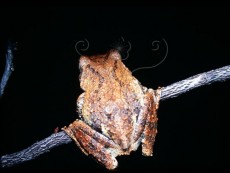|

Scientific Name: Kurixalus idiootocus Kuramato & Wang, 1987
Common Name: Temple treefrog
Chinese name: 面天樹蛙
~~Introduction~~
The Temple treefrog is endemic to Taiwan. In addition to the eastern part of Taiwan, its distribution range includes mountainous areas at 1500 meters and below throughout Taiwan. Its habitats include forests, bamboo groves, grassy thickets and wetlands. It stays in moist mud in the daytime and appears on leaves at night. This frog feeds on lepidopteran larvae, ants and spiders. Breeding season is between February and September, peaking between June and August.
~~Morphological Characteristics~~
Adults: The Temple treefrog is a small-sized frog. Males are about 2-3cm and females 4-5cm. The skin is rough with many round or long warts of all sizes, which are not tipped with white prickles. The snout is pointed. The head length and head width are the same. The tympanum is round and indistinct. Between the eyes is an inverted triangular marking. The dorsal color is light gray or yellowish brown, with an X- or H-shaped dark spot. The mid-dorsal stripe is absent. There is no dorsolateral fold on the flanks. The belly is white and covered with some grayish black spots.
On the outside of forearms and hands are some white tubercles and black transverse stripes. The fingers are slightly webbed with disks on the tips. Inner metacarpal tubercles are indistinct. There are black transverse stripes on the ventral side of hindlimbs and a zigzag of white tubercles on the outside of the shank and the foot. The white tubercles on the tibiotarsus of the hindlimbs are particularly large. Toes are half webbed with well-developed disks on the toetips. This species lacks outer metatarsal tubercles.
Secondary sexual characteristics: The male has a single vocal sac under the throat. On the first and second fingers are white nuptial pads.
Tadpoles:
Color: The dorsum of the body is uniformly light brown. The fin is translucent. There are narrow bands on the lateral sides of fin and tail muscle.
Body shape: 7.6~9.2mm (stage 34~37); oval
Snout: Pointed
Mouth: Ventral
Labial tooth row formula (LTRF): 5(2-5)/3(1)
Eyes: Dorso-lateral
Spiracles: Lower lateral
Tail: Lanceolate; pointed at the tip
~~Taxonomic Studies~~
|
Author
|
Kuramato, M., and C. S. Wang.
|
|
Year of publication
|
1987
|
|
Person credited with discovery
|
Yi-Ru Yang
|
|
Date of discovery
|
April 1984
|
|
Reference
|
Kuramato, M., and C. S. Wang. 1987. A new Rhacophorid Treefrog from Taiwan, with Comparisons to Chirixalus eiffingeri (Anura:Rhacophoridae). Copeia, 1987(4):931-942.
|
|
Type specimen classification
|
【Holotype】
‧Sex: ♂
‧Storage location: NTUMA 1010; Museum of the Department of Zoology , National Taiwan University
|
|
【Paratype】
‧No. of specimens: 45
‧Sex: 35♂10♀
‧Storage location:
NTUMA 0926,1005-1009,1011-1029; Museum of the Department of Zoology , National Taiwan University
FUE 84207-84226;Department of Biology , Fukuoka University of Education
|
|
Scientific name changes
|
None
|
~~Ecology and Behavior~~
The Temple tree frog inhabits forests, grassy thickets, paddy fields and ponds. It stays in moist mud in the daytime and appears on leaves at night. Its calls can be heard almost all year round and are similar to those of Eiffinger's tree frog (Chirixalus eiffingeri). Breeding season is between February and September, peaking between June and August. Males often call from bushes, leaves, hideouts in mud or the forest ground to attract females, but sometimes approach mates. After mating, the female lays about 100-200 eggs at one time in moist mud or under fallen leaves. The eggs are grayish brown and contained in a thick layer of gelatinous covering. This frog feeds on ants, spiders and lepidopteran larvae.
The international digital archives and e-learning communication project of the National Museum of Natural Science
|